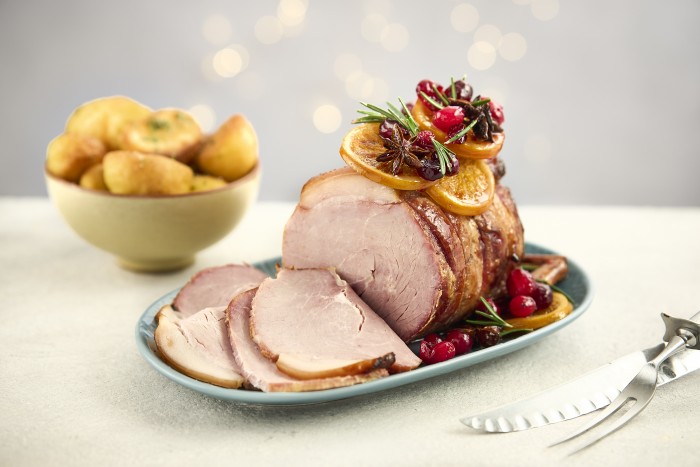Demand for gammon joints increased in the run-up to Christmas, but pork joint sales were down, despite the fall-off in traditional turkey sales, Kantar shows.
Grocery sales breached the £12 billion mark for the first time during the four weeks ending December 25, as grocery price inflation drove value sales. However, volumes were down 1% year-on-year, despite December being the grocery market’s busiest month since the start of the pandemic.
Shoppers continued to trade down from brands to private label, while the discounters (Aldi and Lidl) remained the fastest growing grocers, according to AHDB retail insight manager Rebecca Gladman.
Overall volumes of meat, fish and poultry (MFP) were largely flat (-0.3%) in December, with total volumes of red meat seeing marginal gains. Given the total grocery context of -1% volumes, this is a real positive for the category, Ms Gladman added.
Christmas turkey sales were down 13%, as the sector was hit by avian flu and warnings of supply issues in the run-up to Christmas, although turkey crowns and joints were up 4.8% .
But it was a largely positive Christmas for red meat roasting joints, with lamb, beef and gammon joints all in year-on-year volume growth.
While gammon volumes were up 2.1% on 2021, there was a 3.4% fall in pork roasting joint volumes, driven by declines in leg and loin joint sales, while shoulder joints remained in growth, as pork roasting retail prices increased more than other product.
However, pork roasting volumes were up nearly 9% when compared to 2019, the last ‘normal’ Christmas, while pork and gammon combined accounted for just under a quarter of all roasting volumes in December, Ms Gladman.
Lamb was the standout performer, with both leg and shoulder joints gaining. Leg roasting volumes increased by 10.6%, while shoulder rose by 3.9%. Beef roasting joints were up 2.2%.
Chicken was the main challenger to red meat and turkey, with volumes of whole chickens rising 11.9% year-on-year, accounting for 23% of roasting volumes in December. Despite the price of whole chickens rising 11% over this period, it remains much lower in cost than other proteins, and this volume increase continues a trend seen in recent months.
Price inflation
With Kantar’s measure of grocery price inflation standing at 14.4% in December, prices were up across the board. Pork roasting experienced the largest overall increase in price, linked to a reduction in promotions.
While lamb roasting remains the most expensive meat, it had the smallest year-on-year increase in average price. The volume of lamb sold on promotion was up slightly (at 49%), but it was the depth of discount that rose and likely enticed shoppers to the category, Ms Gladman added.
“This highlights how promotional activity can be used to attract shoppers to more expensive cuts, despite the cost-of-living backdrop,” she said.




